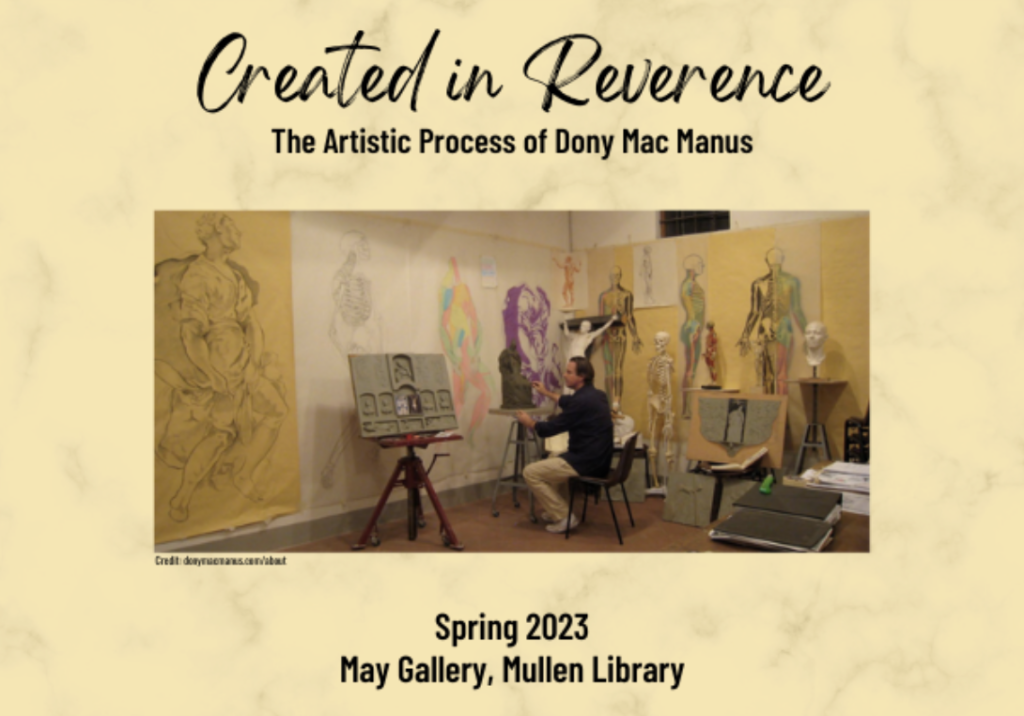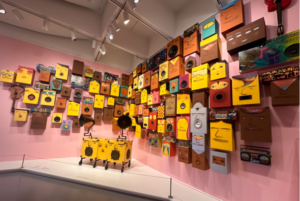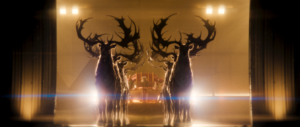CUA Resident Artist Exhibits in Mullen Library

Image Courtesy of Mullen Library
By Eduardo Castillon
On Tuesday, February 28, 2023, I had the pleasure of speaking with the Catholic University of America’s (CUA) first Artist in Residence, Professor Dony MacManus. Throughout the Spring 2023 semester, MacManus’ art will be displayed in the Mullen Library’s May Gallery for students to enjoy. Created in Reverence, the title of the exhibit asks the question, what drives artists to create? I explored this fundamental theme with MacManus and his new role as CUA’s Artist in Residence.
MacManus completed a two year masters program on figurative art at the New York Academy of Art. During his time there he explored his faith through artistic anatomy to better understand Christ’s incarnation. While working on a large crucifix (which is currently displayed at Mullen Library), a priest visiting MacManus’ studio pointed him towards John Paul II’s Theology of the Body, as the priest could see similar ideas in MacManus’ art. It was after this that MacManus realized that even though the Academy’s students were learning everything about the body, they weren’t being taught what it truly meant. In many of the students MacManus has taught, he could see their art being used simply to boost egos or pervert art itself. This led him to emphasize the importance of artists’ interior lives. Without cultivating one’s inner world towards the greater truth, one cannot make sacred art. Using theology of the body, MacManus hopes for a re-evangelization of the world and a mending of people’s interior lives that have become so divided in modernity.
“The foundation of all culture is our interior life,” MacManus said. “What an artist does is he externalizes his interior life. If we have an unhealthy interior life, we destroy our culture. If we have a healthy interior life, we lift our culture.” This profound conception of art informs much of MacManus’ worldview and guides him in his designed curriculum for CUA’s aspiring artists.
MacManus finished the great crucifix in 2001, and it was displayed at the Academy’s graduation show. However, a fire caught light in the school and seriously damaged the figure. It was both a traumatic and transformational year for MacManus. Two weeks after the fire at the Academy, the September 11th attack on the World Trade Center would occur. Additionally, MacManus would lose two people close to him to suicide.
After this dark period, MacManus left New York for a commission in Rome, where he spent three weeks drawing the Pieta. While studying the sacred sculpture, MacManus had a transformative experience.
“During that period I experienced a tremendous healing and a renewal in my faith in God, humanity, and my vocation as an artist.” Seeing people transformed at the Pieta, MacManus decided that his mission would be to bring such sacred art to today’s generation.
One of the historical challenges to that mission, in MacManus’ eyes, is the modern art establishment and, in particular, a “culture of repudiation.” MacManus laments the influence of thinkers like Foucault, Derrida, and the members of the Frankfurt School in deconstructing western cultural foundations. This disagreement with contemporary attitudes in the art world led him to switch programs at the National College of Art and Design in Dublin.
“The art department when I was studying there in the 90’s was run by the revolutionaries of the 70’s,” said MacManus. “They spent their time in college destroying plaster casts of the great masters. When they were pushing those plaster casts out of the third story building and crashing them onto the streets below, it took about five seconds for that sculpture to be destroyed. But it took me five years to reconstruct that understanding.”
MacManus,however, is not discouraged. He believes the ability of sacred art to open the door for truth, beauty, and goodness allows for a repudiation of the culture of repudiation.
Thomas Aquinas’ “recto ratio factibilium”, or right reason in regard to the making of things, guides the creative process MacManus wishes to instill in his students. Not only should they cultivate their inner life to pour out into their art, but they also need artistic “grammar” to be proficient in their craft. Texture, tone, color are essential for artists to understand in order to better project that interior world.
“You need to have a clarity of understanding of your relationship with God, which is essentially humility, and your relationship with others.” MacManus said, “And if you’re an artist you need to do that visually and that means drawing, drawing, drawing. To draw is to think visually.” This astute understanding of what comprises an artistic education will be the basis for curriculum MacManus will be designing as CUA’s Artist in Residence.
Professor MacManus has many plans for the future, building on the experience he gained after founding the Irish Academy of Figurative Art and the diocesan Sacred Art School in Florence. In particular, the Artist in Residence is interested in the possibility of incorporating the Sacred Art School in Florence with CUA’s study abroad programs.
When asked about which piece of art presented for Created in Reverence was his personal favorite, Professor MacManus was torn between the crucifix from 2001 and the Fountain of Life sketch. While it was conceived in Rome, the Fountain of Life was later realized in clay full size. The impressive twelve foot tall mold currently resides in his studio and it’s his hope that students will have an amazing opportunity to learn how sculptures are made.
The artwork features two figures back to back holding a child aloft, symbolizing the culture of life, and below them is a skeleton pulling them down, symbolizing the culture of death. Such a pro-life monument, according to MacManus, would be ideal at CUA, which he regards as the definitive pro-life university. The Artist in Residence wishes for the sculpture to act as a symbol of hope for the university, the students, faculty, and the surrounding community.





